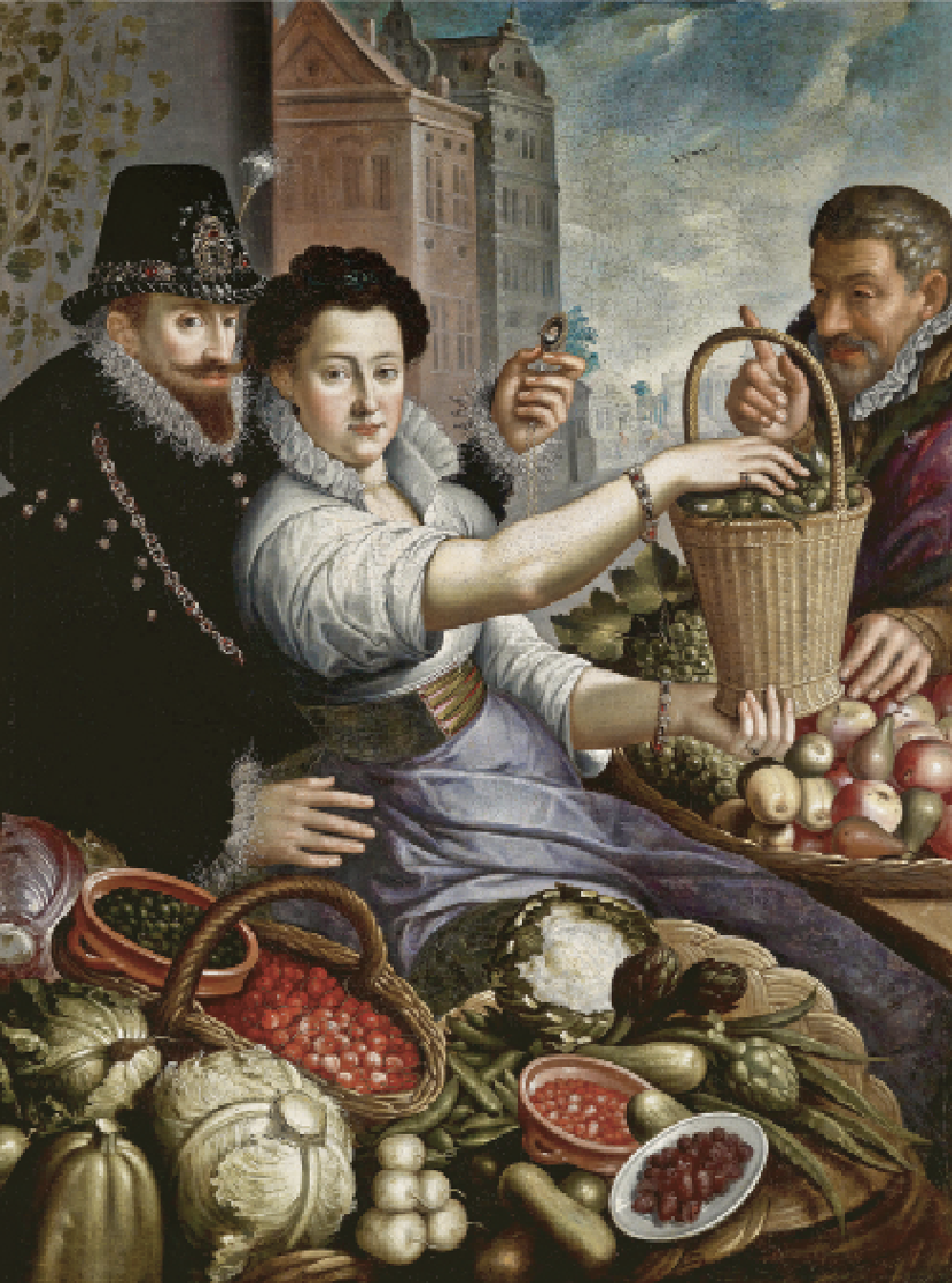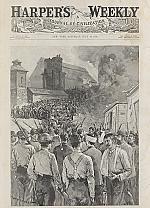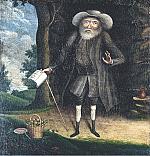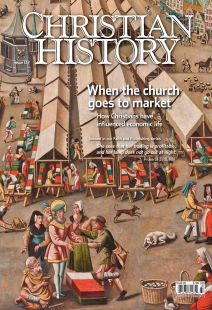Bringing profit to neighbors

[Jan Baptist Saive the Younger, Portrait of an aristocratic couple as vegetable sellers, 1624—Dorotheum / [Public domain] Wikimedia]
The world asks, “What does a man own?”; Christ asks, “How does he use it?”—Andrew Murray (1828–1917), Dutch Reformed missionary in South Africa
Economic growth doesn’t have much of a history, at least for the first few thousand years. By the measures we use today, such as gross domestic product per capita, essentially no economic growth happened from antiquity to 1500 AD. At the same time, great inequality existed in the material wealth and experiences of daily life between the elites—kings, queens, emperors, and later popes and bishops—and nearly everyone else. Massive inequality and widespread poverty were unalterable and universal realities of the ancient world.
Moreover, those who enjoyed a position at the top with greater wealth and privileges often had obvious advantages: they were in some way bigger or faster or stronger (or all three)—more often than not simply by virtue of birth. They expanded power and influence through conquest of other peoples and extraction from their own. The mighty ruled, taking what they wanted, and their underlings scraped out as much of a living as they could with the leftovers.
Some technological advances—chariots, for example, or iron swords—temporarily gave one ruler or group an advantage over another. But the basic theme remained: the wealthy rulers enjoyed the vast majority of whatever material and social benefits existed.
The worldview that makes sense of these realities is today called the theory of “limited good”: only so many goods exist to go around, so wealth claimed by the rich must by definition have been taken from the poor. In a world defined by extraction and conquest, the only people with power clearly achieved it through force and at someone else’s expense.
Bearing no fruit
In the Middle Ages, this view of limited economic good corresponded to the regimented hierarchy of feudal society: the aristocracy and nobility were born to rule, while peasants and serfs were bound to be ruled.
The medieval European world was complex and highly stratified. Authorities and jurisdictions competed: emperor and pope, prince and cardinal, lord and bishop. The Middle Ages shared with the ancient worldview the basic perspective of a finite number of material goods. The feudal economy revolved around lands dedicated to farming and agriculture.
Aristotle’s evaluation of money formed a foundational point for medieval economic theory. Aristotle had observed a key difference between money and living things, like wheat or sheep. According to Aristotle money is sterile; it cannot reproduce. Thomas Aquinas (1225–1274) affirmed this basic Aristotelian understanding, drawing a distinction between things that bear fruit and things that bear no fruit; he put money into the latter category, along with pottery (and presumably other inanimate objects).
This distinction between the living nature of things like plants and the sterile nature of money was critical for the feudal land-based economy. Crops could be renewed every season. By contrast money was consumed (at least as far as its owner was concerned) when it was spent. Thus Aquinas observed that “the proper and principal use of money is its consumption or alienation [giving away] whereby it is sunk in exchange.”
Is land sterile or does it reproduce? Land has the possibility of being farmed, so in some sense it reproduces. A seed sown and tended can grow to become something fruitful, such that we can even imagine a crop “a hundred, sixty, or thirty times what was sown” (Matt 13:8).
Even so, one could gain only a finite and limited amount of such land: if you had only one acre, you could only reproduce a finite amount of vegetables, no matter how good your farming practices were. Furthermore, one lord might acquire land from another—through purchase, conquest, or deceit—but the land could only have one owner at a time.
The theory of limited good persisted through the medieval into the early modern period, which became a significant transitional phase of technological, economic, and scientific development. One famous champion of the traditional view was French Roman Catholic essayist and philosopher Michel de Montaigne (1533–1592)
In the first book of his Essays, Montaigne summarized the ancient theory of limited good with the formula, “One man’s profit is another man’s harm.” He went on to describe the ways in which various professions are only possible because of the harmful effects they have on others:
The merchant does good business only by the extravagance of youth . . . the plowman by the high cost of grain; the architect by the ruin of houses; officers of justice by men’s lawsuits and quarrels; the very honor and function of ministers of religion is derived from our death and our vices.
For Montaigne the theory of limited good seems to have an even stronger application: the law of competitive struggle—of all against all—is not constrained to the economic sphere. Rather such conflict encompasses all of human existence and is a fundamental feature of the law of nature. Just as can be observed in the life cycle of a stalk of wheat, “the birth, nourishment, and growth of each thing is the alteration and corruption of another.”
Another man’s gain
Montaigne’s view that “no profit is made except at the expense of others” continued to predominate in the sixteenth and seventeenth centuries, even among figures who were less antagonistic toward commerce. In his Treatise on the Alteration of Money, the Jesuit scholastic Juan de Mariana (1536–1624) agreed that “one man’s loss is another man’s gain. There is no way around that fact.”
A closer reading of Mariana’s views, however, shows that he did not understand this claim as a universal truth concerning all of human existence, but only about the entire feudal system, its royal apparatus and rigid hierarchy designed to extract and oppress.
The common order of love
Mariana’s claim left open the possibility that other kinds of human societies or relationships not characterized by such zero-sum competition could thrive. As the Reformation progressed and more dynamic understandings of vocation came to the fore (see CH #110), greater possibilities opened up for the realization of what Martin Luther (1483–1546) called “the common order of Christian love,” in which the interests and good of all might be pursued.
Luther identified three basic social institutions: marriage, church, and government. But these three did not exhaust the possibilities for human society. “Above these three institutions and orders,” wrote Luther, “is the common order of Christian love, in which one serves not only the three orders, but also serves every needy person in general with all kinds of benevolent deeds.”
This order of love is a creative sphere of service, which can take a variety of forms in a diverse array of contexts as we follow Christ’s command to love one another. Luther believed human actions, even human profits, must not necessarily come at the expense of others but can actually be acts of love for our neighbors.
This order of love is one reason Luther taught that “everyone should examine his gift.” He believed that “just as we are unequal in our bodies, our talents, and our property, so we are unequal in spiritual gifts,” and each person is called according to these diverse allotments to a different place and a different form of service. Luther did provide a warning: “Everyone should remain in his place in the moral law and the common right until God calls or compels him to do something special.” But even so Luther’s focus on the particular and unique gifting of the individual person and the obligation to use that gifting for various forms of service represents an important shift from the more rigid social stratification of previous eras.
In this way a new vision of vocation opened up in the Reformation period, one that saw increasing possibilities for creative service in the burgeoning modern world. The Strasbourg reformer Martin Bucer (1491–1551) urged in his Instruction in Christian Love (1523) that “children should be encouraged to enter the best profession, and the best profession is the one that brings most profit to neighbors.”
While praising service as a civil magistrate or a Christian minister, Bucer identified another set of professions as especially worthy for Christian service: “agriculture, cattle-raising, and the necessary occupations therewith connected” are “the most profitable to the neighbors and cause them the least trouble.”
At the same time, as figures like Luther and Bucer encouraged Christians to pursue their Christian calling in the way that was of most service to their neighbors, more and more people were moving from farms to cities.
The produce of medieval farms had been sold at market fairs, but the increasing urbanization of European society in the early modern era allowed greater reliability and variety for both buyers and sellers. The historian Brad Gregory identified cities and towns as “permanent fairs,” places where the opportunities for exchange of mundane as well as specialty goods became commonplace.
With the rise of these increasingly prosperous cities, new classes of society began to enjoy greater prominence and power. The middle classes increasingly became the driving force of economic growth and development, and the virtues necessary for success in commerce and trade—such as honesty, diligence, hope, and prudence—enjoyed newfound cultural and social legitimacy (see p. 11).
Morals and wealth
The need for productive land, both for the maintenance of society and for the realization of agricultural vocations, remained central to European economies throughout the sixteenth and seventeenth centuries. In fact the scarcity of available land in Europe was one of the factors that motivated migration to the Americas, where a seemingly abundant land of opportunity awaited.
Material and social concerns led to colonization and migration abroad as well as to transition and upheaval in Europe; simultaneously, important theoretical developments underpinned the changing West. Scottish moral philosopher Adam Smith (1723–1790) was the leading advocate of a new kind of political economy (see p. 27) that focused not primarily on competition for limited goods but rather extolled the possibilities for mutually beneficial exchange. Working out of the context of the Scottish Enlightenment, Smith championed an economic view that would help modern societies develop their morals as well as their material wealth.
One of Smith’s main targets was the mercantilist system of his day, which saw the competition between nations in traditional terms: the more gold bullion (pieces of gold) held by England, for instance, the less gold available for rivals like France, and therefore the stronger England would become. This is essentially the ancient vision of limited good applied to the imperial and colonial geopolitics of the eighteenth century.
Smith observed that in general, a straightforward market transaction involves the improvement of both parties. When something is on sale in a market, he wrote in The Wealth of Nations, “Give me that which I want, and you shall have this which you want, is the meaning of every such offer; and it is in this manner that we obtain from one another the far greater part of those good offices which we stand in need of.”
Smith applied this vision as well to international relations, arguing that the wealth of nations derives not so much from a nation’s stockpiled commodities—whether gold or wheat or iron—but rather from how much the country has developed its own economy to participate productively in international exchange.
It might serve best for one nation to focus on producing corn while a second nation produces some other good, like grapes or wheat. As both focus on more specialized production, they can trade the proceeds so that both end up with more corn as well as grapes than either could achieve alone.
English economist David Ricardo (1772–1823) later explained this insight mathematically through influential illustrations; and Anglican clergyman Thomas Robert Malthus (1766–1834) took the new approach and applied it to the question of productive land and what seemed to him to be the inherent limits of economic growth.
The limits of the limited Good
The theory of limited good, or the idea that winning and losing characterize every social, economic, and political interaction, persists to this day. In certain contexts and instances, some finite goods cannot be enjoyed equally; at least in the traditional Western terms of ownership, only one person can own a particular plot of land or hold a particular office, for example.
The key question, however, is whether this dynamic is inevitable and universal, or whether it is possible for mutually beneficial exchanges to occur, not just in the everyday cases of trades and barters but even at the level of international relations. If a reality in which the rich and powerful only achieved their status at the expense of others characterized the ancient world, then the modern world has produced a reaction against such a zero-sum perspective.
Reformers like Luther and Bucer as well as later theorists like Smith helped to show that the realm of creative service and mutual benefit can be broader than previously thought. But these developments have left us with an important question: how do we determine the proper scope and limits of such mutually beneficial relationships?
This is a question for economists, to be sure. But Luther would remind us that it is also a question for the church: how best can we participate in the common order of Christian love? CH
By Jordan J. Ballor
[Christian History originally published this article in Christian History Issue #137 in 2020]
Jordan J. Ballor is senior research fellow and director of publishing at the Acton Institute and the author of Ecumenical Babel and Get Your Hands Dirty.Next articles
Avoiding shipwrecks
Catholic papal encyclicals recommended a middle way on economic issues
Kevin SchmiesingFriendly economics
How Quakers in North Carolina used the marketplace to free enslaved people from bondage
Christina HitchcockSupport us
Christian History Institute (CHI) is a non-profit Pennsylvania corporation founded in 1982. Your donations support the continuation of this ministry
Donate





